高三一轮复习名词和冠词课件 (共74张PPT)
文档属性
| 名称 | 高三一轮复习名词和冠词课件 (共74张PPT) | 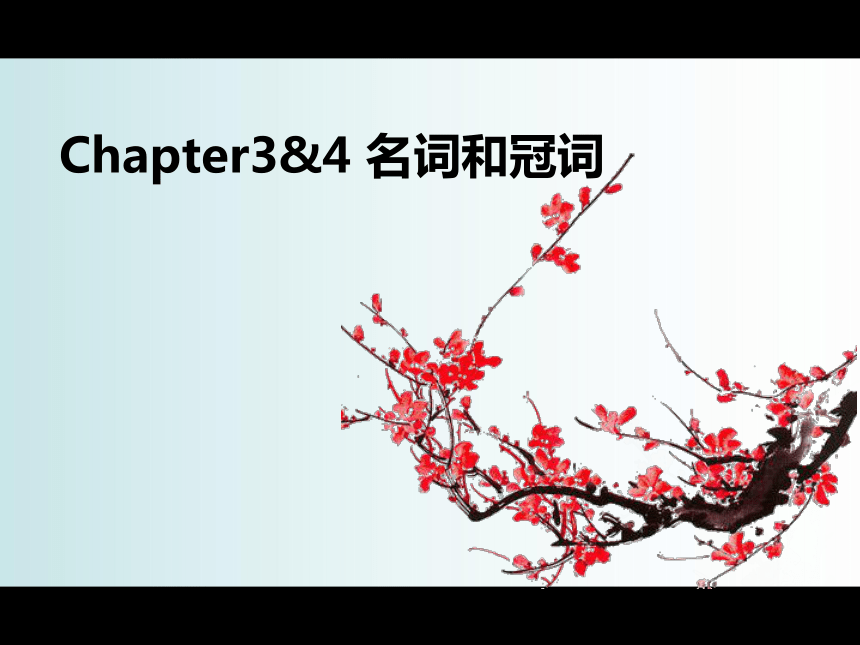 | |
| 格式 | zip | ||
| 文件大小 | 811.1KB | ||
| 资源类型 | 教案 | ||
| 版本资源 | 通用版 | ||
| 科目 | 英语 | ||
| 更新时间 | 2018-11-30 11:00:08 | ||
图片预览


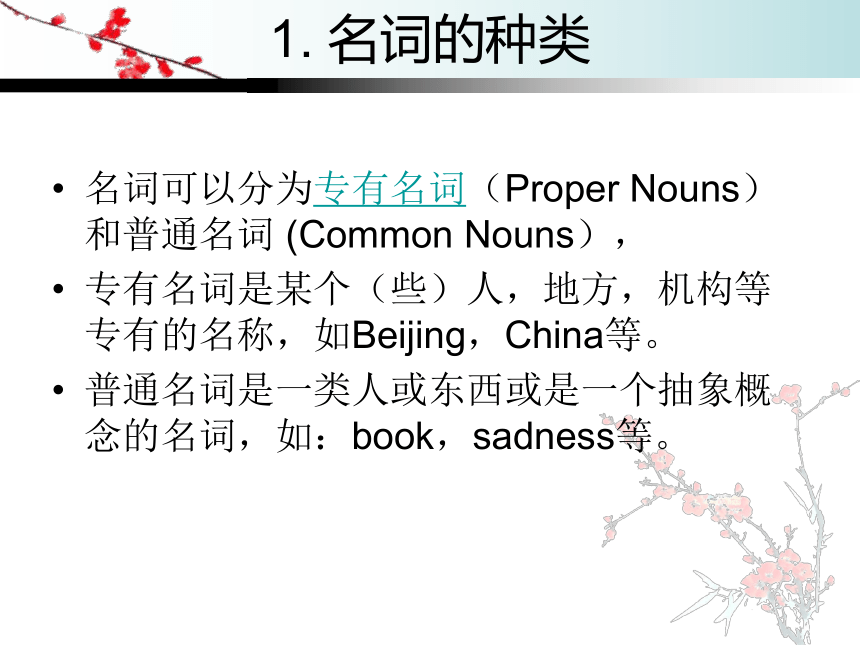
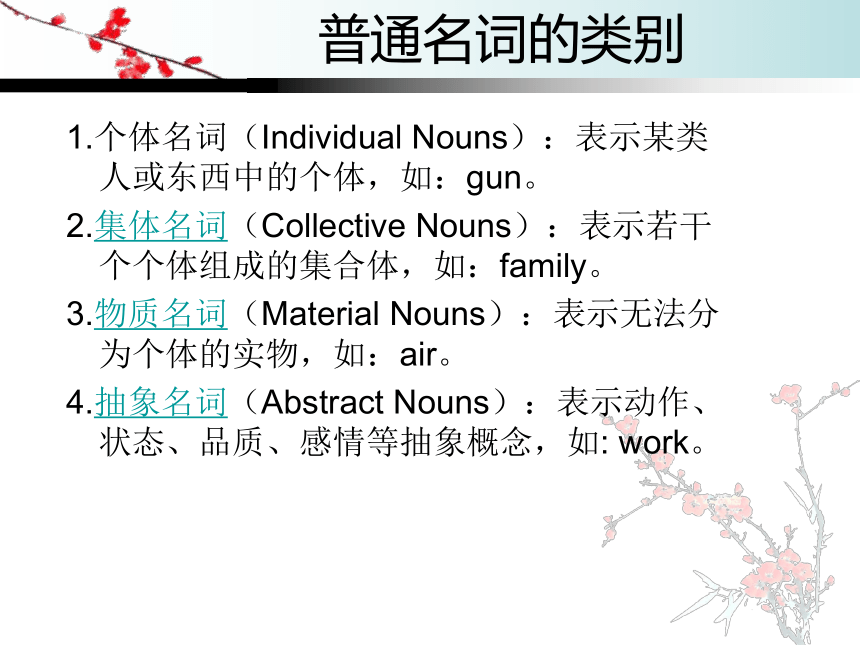
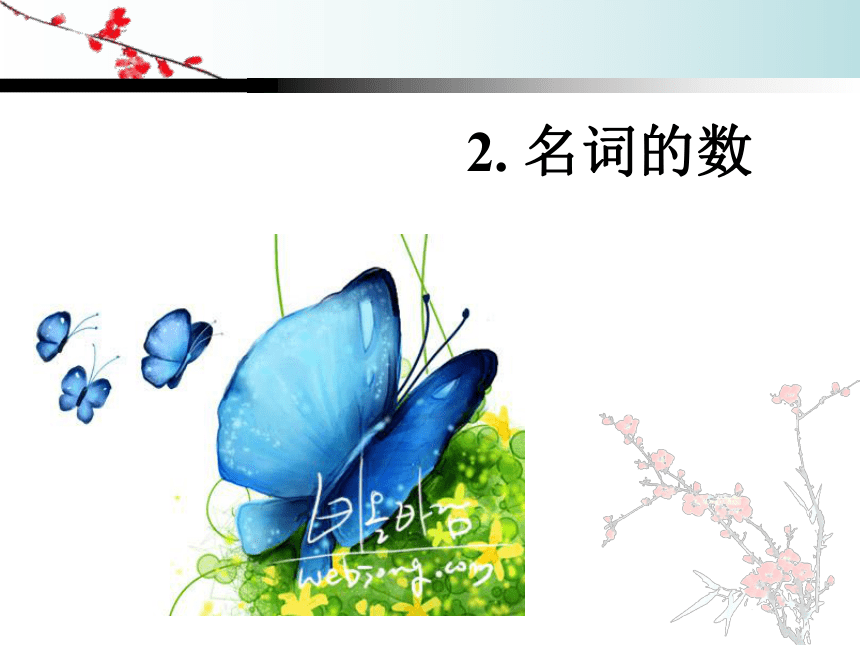
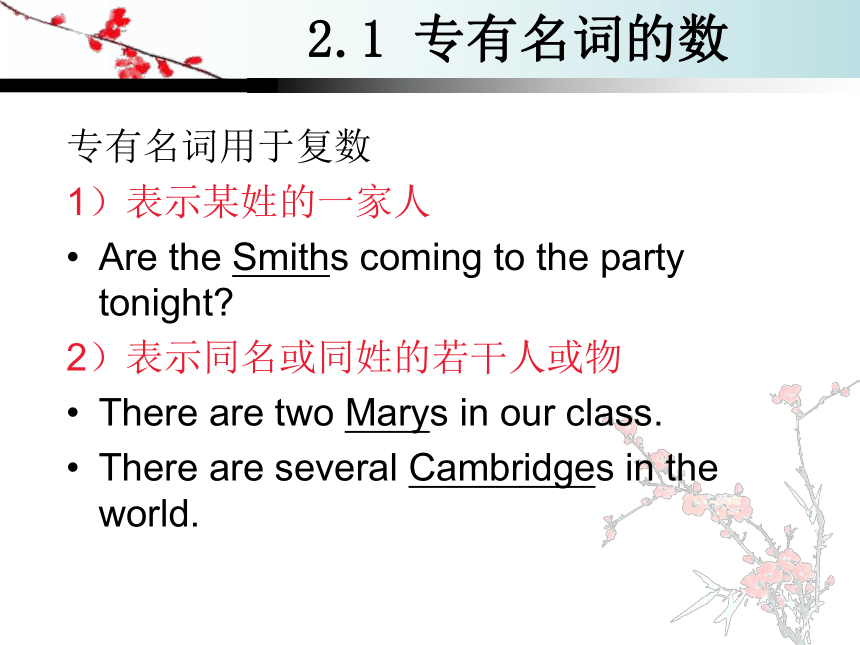






文档简介
课件74张PPT。Chapter3&4 名词和冠词content1. 名词的种类2. 名词的数3. 名词的复数形式4. 名词所有格名 词5. 名词作定语1. 名词的种类
名词可以分为专有名词(Proper Nouns)和普通名词 (Common Nouns),
专有名词是某个(些)人,地方,机构等专有的名称,如Beijing,China等。
普通名词是一类人或东西或是一个抽象概念的名词,如:book,sadness等。
普通名词的类别1.个体名词(Individual Nouns):表示某类人或东西中的个体,如:gun。
2.集体名词(Collective Nouns):表示若干个个体组成的集合体,如:family。
3.物质名词(Material Nouns):表示无法分为个体的实物,如:air。
4.抽象名词(Abstract Nouns):表示动作、状态、品质、感情等抽象概念,如: work。2. 名词的数2.1 专有名词的数专有名词用于复数
1)表示某姓的一家人
Are the Smiths coming to the party tonight?
2)表示同名或同姓的若干人或物
There are two Marys in our class.
There are several Cambridges in the world.2.2 物质名词的数当物质名词转化为个体名词时,可数。
Strike the iron when it is hot.
We supplied electric irons.
当物质名词表示该物质的种类时,可数。
The English do not drink much wine.
It was a delicious French wine.当物质名词表示份数时,可数。
Our country is famous for tea.
Two teas, please.
个别物质名词可以用于复数表示比原意范围更加广阔的意义。
The children are playing on sands.
They were not allowed to fish in the near waters.2.2 物质名词的数(沙滩)(海域)2.3 抽象名词的数当抽象名词转化为个体名词时,可数。例如
Beauty is only skin deep.
His mother was a great beauty in her youth.
当抽象名词前有限定词修饰,表示特指时,可数。例如
The general led his army to victory.
He had a narrow victory in the elections.2.4 集体名词的数1)一些表示无生命物的集体名词,如machinery, equipment, merchandise, furniture, jewelry, clothing等,通常用作单数。
New machinery was introduced in this factory.
The furniture in the room has been made to order.
2)某些有生命物的集体名词,如people, police, cattle, poultry(家禽), vermin(害虫), bacteria等,通常用作复数。
The police are investigating the crime.
Such vermin as bugs and rats are hard to get rid of.2.4 集体名词的数2.4 集体名词的数3)不少集体名词,若视为整体,则作单数看待;若视为一个个成员,则作复数看待。(see p.44)
His family isn’t a big one.
The family were having a chat in the living room.2.5 不可数名词量的变化有些抽象名词和物质名词可以兼作个体名词。
物质名词、抽象名词和某些集体名词可以借助单位词表一定的数量。(see p.47)
a glass of water; a piece of advice;
a piece of furniture
an article of clothing
2.6 不可数名词的量化表示
修饰可数名词复数:
many, a good/great many,a good/great/large number of
修饰不可数名词:
much, a great deal of, a large amount of
两者都可修饰:
a lot of, lots of, plenty of, a great/large quantity of, quantities of, a large sum of
3. 名词的复数形式1) 有些常用名词和外来词有不规则的复数形式,如:
mouse; crisis; medium; stimulus; phenomenon
mice; crises; media; stimuli; phenomena
3.1 不规则的名词复数形式3.1 不规则的名词复数形式2)有些名词单复数同形,如:
deer, sheep, fish; aircraft; Chinese, Japanese; species, means, offspring; li, jin, yuan等。
I’m a Chinese.
The Chinese are industrious and brave.
注意:除人民币元、角、分外,美元、英镑、法郎等都有复数形式。如:a dollar, two dollars; a meter, two meters3.1 不规则的名词复数形式3) 合成词的复数形式
第一个词素变复数
如:daughters-in-law, lookers-on
第一个和最后一个词素都变为复数
如:menservants, women doctors
最后一个词素变复数
如:boy friends, toothpicks, grown-ups, stand-bys; firemen
以-s结尾,但通常视为单数的词
1)某些学科的名称,多以-ics结尾
如:physics, mathematics, statistics, politics等
2)某些疾病的名称
如:measles, diabetes, AIDS, mumps, bronchitis等
3.2 某些以-s结尾的名词3)某些游戏的名称
如:cards, darts, bowls, draughts/checkers (A.E), billiards等。
4) news,summons (传票)等虽以复数形式出现,但不表示复数意义的词
如:Good news goes on crutches;ill news flies apace. 3.2 某些以-s结尾的名词5)某些书名、报纸名、杂志名、地名、国名、组织名及建筑物名,虽以复数形式出现,但表示的是一个事物,所以谓语动词须用单数。
"The Arabian Nights" is a very interesting story-book.
When was the United Nations established?
3.2 某些以-s结尾的名词以-s 结尾,通常视为复数的词
1)由两部分构成的物体的名称,如:
The scissors are dull. But they are my only pair.
注意:如果这类名词前用了a pair of等,则往往视为单数。如:
A pair of scissors is lying on the table.3.2 某些以-s结尾的名词2) 以-ings结尾的名词,如:
All my belongings are in the bag.
3) 以复数形式出现有特殊意义的词,如:
Philippine authorities are investigating the incident.
Middle East peace talks are doomed to fail.
但也有少数仍视为单数,如:
Hong Kong customs has participated in this project.
3.2 某些以-s结尾的名词 4.
名词所有格4.1 名词所有格的形式1)表示有生命物体的名词后用’s,无生命的一般用of结构
the boy’s bag the cover of the book
2)复合名词或短语,’s 加在最后一个词的词尾。
a month or two's absence
3)如果两个名词并列,并且分别有’s,则表示“分别有”;只有一个’s,则表示“共有”。
John's and Mary's rooms(两间)
John and Mary's room(一间)
4)在表示店铺、教堂或某人的家时, ’s所有格后面常常省略它所修饰的名词。
the barber’s 理发店4.2 “’s”与 “of”两种所有格的区别只能用“’s”的所有格形式
1)在表类别或属性时,如
children’s books a women’s college
2)在某些成语中时
within a stone’s throw(近在咫尺)
3)当名词中心词之后带有同位语时,如
The salesman’s brother, a postman, was here this morning.4)表示时间、距离、价格、国家城市等地方、集体或机构的名词之后也用’s所有格。
today’s newspaper
China’s reform and opening-up4.2 “’s”与 “of”两种所有格的区别只能用“of ”的所有格形式
1)当名词后面跟有后置修饰语时
Do you know the opinion of the committee appointed a few days ago?
2)当名词是由“the+adj.”构成时
The rulers paid the least attention to the welfare of the poor.
3)当所有格结构表示同位关系时
the name of Kate4.2 “’s”与 “of”两种所有格的区别名词所有格除表示“所有关系”外,还可有一些特殊意义。如表示主动关系、被动关系、同位关系以及特征。
John’s gift to Mary was a watch.(主动/主谓关系)
TV is bad for Children’s education.
(被动/动宾关系)
the city of Paris(同位关系)
He has a doctor’s degree.(特征/类别)4.3 名词所有格的一些特殊意义1) 构成:
(a, this, that, few, some, three…)+名词+of+名词所有格/名词性物主代词
2) 意义:表示整体中的一个或部分。
3) of前面的名词通常有一个不定冠词、数量词(包括some, few等)或指示代词修饰。
that girl of your brother’s. (不能是the)
4) of后面的名词必须是确定特指的,且一般指人。
some books of the teacher’s (不能是a)4.4 名词双重所有格of前面的名词有this, that等词修饰时,可表示欣赏或厌恶的口吻。
That wife of Mr. Li’s is constantly complaining.4.4 名词双重所有格4.5 名词的双重所有格与“of + 名词”结构之间的区别句子所表达的侧重点不同。试比较:
He is a friend of my father's.
He is a friend of my father.
of前面是picture等词时,含义不同。试比较:
This is a picture of my mother's.
This is a picture of my mother.
(着重说明“父亲”的朋友不止一个)
(着重说明“他”是父亲的一个朋友)
这是我母亲收藏的一张照片。这是我母亲的一张照片。(照片中的人是我母亲)5. 名词做定语5. 名词作定语 通常用单数形式,说明中心名词的材料、用途、时间、地点、内容、类别等。
a diamond ring a meeting room
evening suits the kitchen window;
a story book beauty contest
但有少数名词作定语时仍以复数形式出现。
1)表示特定意义时本身就是复数形式的名词。
savings account customs officer
2)有些复数名词作定语可看作复数名词所有格作定语的省略,一般表示对象,如:
teachers college girls shop
3)man, woman修饰复数名词时
men engineers women doctors5. 名词作定语4)dozen, score, hundred, thousand, million等,表示具体数目(即有数词修饰)时,用单数形式;表示笼统数目时,用复数形式。
two-dozen eggs 两打/二十四个鸡蛋
dozens of times 许多次
5. 名词作定语名词作定语与其同根形容词作定语的区别:
a gold watch = a watch made of gold
a golden watch = a watch looking like gold
名词作定语多表明内容或实质,形容词作定语则常用来描述其特征。
5. 名词作定语名词作定语与名词所有格作定语的区别:
名词作定语强调“类指”,而名词所有格则表示“特指”。
a garden chair 花园用的椅子
your government's policy 你们政府的政策
如果放在句中,其区别就更明显:
Please don‘t put the dog’s food under the table.
Dog food costs as much as meal.
前句 dog's food,特指给某一条狗食用的。后者指类别,即供狗食用的食品,并非只给某条狗食用。5. 名词作定语不定冠词冠词定冠词零冠词不定冠词的用法和位置定冠词的用法和位置零冠词的用法三种冠词的类指用法比较冠 词冠词的类别不定冠词 (Indefinite article): a, an
只可以和单数可数名词搭配
定冠词 (Definite article): the
置于单数可数名词、复数可数名词和不可数名词之前
零冠词 (zero article)
通常与复数可数名词或不可数名词搭配,用以泛指一类人或物不定冠词的用法(1)泛指用法:
指某人或某物,意为a certain
A car is waiting at the gate.
A Mr. Lin is waiting for you.不定冠词的用法(2)类指用法
泛指一类人或物,意为any, every
A knife is a tool for cutting with.
A child needs love.
泛指一个人的职业、宗教、身份等
His father is a carpenter.
Is the visitor a Christian?
不定冠词的用法(3)指量用法
表示"一个",意为one
A stitch in time saves nine.
和表示时间或度量衡的名词连用,意为per
Take the medicine three times a day.
用在和数词hundred, thousand, million以及名词dozen, score等连用
There are a dozen eggs in the basket.
表示”同一”、“相同”
Things of a kind come together, so do people of a mind.(物以类聚,人以群分)不定冠词的用法(4)用在不可数名词前,表示
一种
Mao-tai is a famous Chinese wine.
一场,一阵
It was a just war.
一次,一例,一份
I want a strawberry ice-cream.不定冠词的用法(4)用在不可数名词前,表示
引起某种情绪的人或事
He is a shame to his family.
The work has been a great joy.
某种品质的具体行动、人或东西
Would you do me a favor?
You were a great help to us.不定冠词的用法(5)用在某些固定短语中
如:as a matter of fact, in a hurry , in a word不定冠词的位置正常语序为:不定冠词+形容词+名词
用在such,what,many,half等词之后
I have never seen such an animal.
Many a man is fit for the job.
用在as ( so, too, how)+形容词之后
I’ve never met so nice a girl.
It was too good an opportunity to miss.
We can see how serious a problem it is.
They are as happy a couple as I’ve ever seen.
(他们是我见到的最幸福的一对。)不定冠词的位置quite,rather与单数名词连用,a/an放在其后。但当名词前还有形容词修饰,a/an放在其前后均可。
He is rather a fool.
It was rather a cold day/a rather cold day.
在as,though 引导的让步状语从句中,当表语为形容词修饰的名词时,不定冠词放形容词后。
Brave a man though he is,he trembles at the sight of snakes. 定冠词的用法(1)类指用法
the+单数可数名词,表示一类人或物
The rose is a fragrant flower.
the+adj./p.p, 表示某一类人或某一类的事情或概念
The young are impatient; they want changes.
The unexpected always happens.
The Welsh are well known for their singing.
the+集体名词或复数名词,表示一定的阶级、阶层、党派或团体
He says he keeps away from the lawyers and the doctors.定冠词的用法(2)特指用法
特指双方都明白的人或物 Take the medicine.
上文提到过的人或事 He bought a house. I’ve been to the house.
指世上独一无二的事物 the sun, the sky, the moon, the earth 定冠词的用法(2)特指用法
用在序数词和形容词最高级之前,有时也可用于形容词比较级之前
The shorter of the two boys is my brother.
用在only, very, same, sole, next, last之前 That’s the very thing I’ve been looking for. 定冠词的用法(2)特指用法
特指人体部位,相当于物主代词
She grabbed me by the arm.
(=She grabbed my arm.)
用在带有限制性后置修饰语的名词之前
I like the film I saw yesterday.
与复数名词连用,指整个群体: I saw two of them last night. (指他们中的两个) I saw the two of them last night. (指他们两个)
定冠词的其他用法用在某些由普通名词构成的专有名词前
the Yangtze River, the Security Council
用在表示乐器的名词之前
She plays the piano.
用在剧院、电影院之前
They go very often to the cinema but they very seldom go to the theatre.
定冠词的其他用法用在表示姓氏的复数名词之前,指一家人 或两夫妇
the Greens
用在表示方位的名词之前
The sun rises in the east and sets in the west.
用在测量单位前面,表示“每”(each/per)
Some factory workers are paid by the hour. 定冠词的其他用法用于逢“十”的复数数词之前,指世纪中的几十年代
He was not in China in the 1930s’.
用在单数可数名词前,表示其属性、功能或有关的抽象概念等
Don’t play the fool. ( )
Peter is too fond of the bottle. ( )装傻嗜酒、贪杯定冠词的其他用法用在the more…the more…的结构中
The more he gets, the more he wants.
用在惯用语中 the day after tomorrow,in the distance, on the whole, by the way定冠词位置 定冠词通常位于名词或名词修饰语前,但放在all, both,double,half,twice,three times等词之后,名词之前。
Both the customers are from America.
I would have gladly paid twice the money for the beautiful car. 零冠词的用法(1)特指用法
零冠词+职位名词
He will be elected president.
零冠词+表示家庭成员的单数名词/nurse, cook, teacher
Mother says that we should help him.
零冠词+专有名词 (国名,人名,语言、报刊名 p.73)
England, Paris, Shakespeare零冠词的用法(2)类指用法
零冠词+物质名词,泛指一类人或物
Snow is white.
零冠词+抽象名词,表示一般的抽象概念
She cared little for social life.
零冠词+复数可数名词,表示一类人或物
Those young men are teachers, not students.零冠词的其他用法在季节、月份、节日、 假日、日期、星期等表示时间的名词之前,不加冠词; Winter in South China is not so cold.
October 1st is our National Day.
但 festival 前须加 the. 如:
After New Year’s Day,the Chinese people are preparing for the coming Spring Festival.
在三餐、球类运动和娱乐运动的名称前,不加冠词
have breakfast,play chess
但有形容词修饰的三餐前要加aan 如 have a quick breakfast
在表示使用何种交通工具的by-词组中,交通工具名称前无冠词
by bus,by train; by air, by sea
在一些并列名词词组前,常不加冠词 (p.80)
Please pass me pencil an paper.
We are brother and sister. 零冠词的其他用法用在表示抽象意义或一般意义的时间名词前
Roosters crow at sunrise and sleep at sunset.
用在turn, go(作“变成”解)之后作补语的名词前
He has gone socialist.零冠词的其他用法用在大部分疾病名称前
She is in hospital with pneumonia (肺炎).
用在作呼唤语或感叹语的名词前
Stay where you are, girl!
Poor fellow! He broke his leg.
用在as引导的让步状语从句 中
Child as Tom is, you can’t fool him.零冠词的其他用法在独立主格结构中,名词前一般不加冠词
He sat at the table, coat off, head down, and pen in hand.
用在(a) kind/sort/species of等表示类属的结构中
What sort of book do you want?零冠词的其他用法有些个体名词不用冠词,如:school,college,hospital,bed,table,class,town,church,court 等,直接置于介词后,表示该名词的深层含义(某种行为)
My son has gone to school.
I am going to the school to see the headmaster.
My son usually go to bed at nine o’clock.
Lie down on the bed.零冠词的其他用法不用冠词的序数词
序数词前有物主代词
It is my first time to make a speech.
序数词作副词
He came first in the race.
在固定词组中
at (the) first, first of all, from first to last三种冠词的类指用法比较语体的差异:“the+单数名词”常用于正式语体。
The/A horse is a useful animal.
Horses are useful animals.
词汇意义的差异(1):a/an作类指通常是指一类中的任何一个,因此下面的例子中不用a。
The tiger is in danger of becoming extinct.
The telephone was invented in 1876. 三种冠词的类指用法比较词汇意义的差异(2):用复数名词作类指可以表示同一类属中的不同种类或个体,因此下面的例子中不能用另外两种结构。
Soldiers wear uniforms.
Flowers are not sold here.冠词的重复如果两个名词指两个人或物,通常在各个名词前都要用冠词
I met a journalist and an author in the club.
有些名词通常成对出现,被视为一体,一般只用一个冠词
There is a horse and cart in front of the tree.
如果两个名词指同一个人或物,或指整体的同一部分,一般只用一个冠词
Have you seen the red and white roses over there?冠词的其他用法问题在某些名词前使用不同冠词,词汇意义有差异。
out of question 根本不可能
out of the question 没有问题
The student in ___ front of me is intelligent.
There is a picture in ___ front of the book.
Some people like to talk at ___ table.
An old man is sitting at ___ table.
/the /the人名前用冠词的意义A Mr. Brown wants to see you.
They thought he was a Zhuge Liang.
The painting on the wall is a Rembrandt.
墙上的这幅是伦勃朗的作品。
He was the Homer of his age.
He’s sitting in the Ford.
他坐在福特牌汽车里。
A few minutes later he was met by an anxious Miss Smith.
几分钟后焦急的史密斯小姐向他迎了上来。冠词使用中的易错点表示世界上独一无二的事物的名词前一般加定冠词the; 但如果名词前有修饰语,也可能用不定冠词a, an。
the world, a peaceful world
the moon, a bright moon
表示一日三餐的名词前面一般不用冠词,但前面如果有了定语修饰,也可能用不定冠词a, an。
Have you had supper?
We had a wonderful supper.冠词使用中的易错点表示乐器的名词前一般用定冠词the, 但前面如果出现定语修饰,也可能用不定冠词a, an。
He starts his day by playing the violin.
He is playing a borrowed violin.
介词与表示交通工具的名词连用表示笼统的方式,前面一般不用冠词,但如果名词的前面出现了修饰语,前面需加冠词。
He went to the station by car.
He went to the station in a black car.冠词使用中的易错点表示语言的名词前一般不用冠词,但后面如果出现language一词,前面需加定冠词the。
English=the English language
French=the French language
Thank you!
名词可以分为专有名词(Proper Nouns)和普通名词 (Common Nouns),
专有名词是某个(些)人,地方,机构等专有的名称,如Beijing,China等。
普通名词是一类人或东西或是一个抽象概念的名词,如:book,sadness等。
普通名词的类别1.个体名词(Individual Nouns):表示某类人或东西中的个体,如:gun。
2.集体名词(Collective Nouns):表示若干个个体组成的集合体,如:family。
3.物质名词(Material Nouns):表示无法分为个体的实物,如:air。
4.抽象名词(Abstract Nouns):表示动作、状态、品质、感情等抽象概念,如: work。2. 名词的数2.1 专有名词的数专有名词用于复数
1)表示某姓的一家人
Are the Smiths coming to the party tonight?
2)表示同名或同姓的若干人或物
There are two Marys in our class.
There are several Cambridges in the world.2.2 物质名词的数当物质名词转化为个体名词时,可数。
Strike the iron when it is hot.
We supplied electric irons.
当物质名词表示该物质的种类时,可数。
The English do not drink much wine.
It was a delicious French wine.当物质名词表示份数时,可数。
Our country is famous for tea.
Two teas, please.
个别物质名词可以用于复数表示比原意范围更加广阔的意义。
The children are playing on sands.
They were not allowed to fish in the near waters.2.2 物质名词的数(沙滩)(海域)2.3 抽象名词的数当抽象名词转化为个体名词时,可数。例如
Beauty is only skin deep.
His mother was a great beauty in her youth.
当抽象名词前有限定词修饰,表示特指时,可数。例如
The general led his army to victory.
He had a narrow victory in the elections.2.4 集体名词的数1)一些表示无生命物的集体名词,如machinery, equipment, merchandise, furniture, jewelry, clothing等,通常用作单数。
New machinery was introduced in this factory.
The furniture in the room has been made to order.
2)某些有生命物的集体名词,如people, police, cattle, poultry(家禽), vermin(害虫), bacteria等,通常用作复数。
The police are investigating the crime.
Such vermin as bugs and rats are hard to get rid of.2.4 集体名词的数2.4 集体名词的数3)不少集体名词,若视为整体,则作单数看待;若视为一个个成员,则作复数看待。(see p.44)
His family isn’t a big one.
The family were having a chat in the living room.2.5 不可数名词量的变化有些抽象名词和物质名词可以兼作个体名词。
物质名词、抽象名词和某些集体名词可以借助单位词表一定的数量。(see p.47)
a glass of water; a piece of advice;
a piece of furniture
an article of clothing
2.6 不可数名词的量化表示
修饰可数名词复数:
many, a good/great many,a good/great/large number of
修饰不可数名词:
much, a great deal of, a large amount of
两者都可修饰:
a lot of, lots of, plenty of, a great/large quantity of, quantities of, a large sum of
3. 名词的复数形式1) 有些常用名词和外来词有不规则的复数形式,如:
mouse; crisis; medium; stimulus; phenomenon
mice; crises; media; stimuli; phenomena
3.1 不规则的名词复数形式3.1 不规则的名词复数形式2)有些名词单复数同形,如:
deer, sheep, fish; aircraft; Chinese, Japanese; species, means, offspring; li, jin, yuan等。
I’m a Chinese.
The Chinese are industrious and brave.
注意:除人民币元、角、分外,美元、英镑、法郎等都有复数形式。如:a dollar, two dollars; a meter, two meters3.1 不规则的名词复数形式3) 合成词的复数形式
第一个词素变复数
如:daughters-in-law, lookers-on
第一个和最后一个词素都变为复数
如:menservants, women doctors
最后一个词素变复数
如:boy friends, toothpicks, grown-ups, stand-bys; firemen
以-s结尾,但通常视为单数的词
1)某些学科的名称,多以-ics结尾
如:physics, mathematics, statistics, politics等
2)某些疾病的名称
如:measles, diabetes, AIDS, mumps, bronchitis等
3.2 某些以-s结尾的名词3)某些游戏的名称
如:cards, darts, bowls, draughts/checkers (A.E), billiards等。
4) news,summons (传票)等虽以复数形式出现,但不表示复数意义的词
如:Good news goes on crutches;ill news flies apace. 3.2 某些以-s结尾的名词5)某些书名、报纸名、杂志名、地名、国名、组织名及建筑物名,虽以复数形式出现,但表示的是一个事物,所以谓语动词须用单数。
"The Arabian Nights" is a very interesting story-book.
When was the United Nations established?
3.2 某些以-s结尾的名词以-s 结尾,通常视为复数的词
1)由两部分构成的物体的名称,如:
The scissors are dull. But they are my only pair.
注意:如果这类名词前用了a pair of等,则往往视为单数。如:
A pair of scissors is lying on the table.3.2 某些以-s结尾的名词2) 以-ings结尾的名词,如:
All my belongings are in the bag.
3) 以复数形式出现有特殊意义的词,如:
Philippine authorities are investigating the incident.
Middle East peace talks are doomed to fail.
但也有少数仍视为单数,如:
Hong Kong customs has participated in this project.
3.2 某些以-s结尾的名词 4.
名词所有格4.1 名词所有格的形式1)表示有生命物体的名词后用’s,无生命的一般用of结构
the boy’s bag the cover of the book
2)复合名词或短语,’s 加在最后一个词的词尾。
a month or two's absence
3)如果两个名词并列,并且分别有’s,则表示“分别有”;只有一个’s,则表示“共有”。
John's and Mary's rooms(两间)
John and Mary's room(一间)
4)在表示店铺、教堂或某人的家时, ’s所有格后面常常省略它所修饰的名词。
the barber’s 理发店4.2 “’s”与 “of”两种所有格的区别只能用“’s”的所有格形式
1)在表类别或属性时,如
children’s books a women’s college
2)在某些成语中时
within a stone’s throw(近在咫尺)
3)当名词中心词之后带有同位语时,如
The salesman’s brother, a postman, was here this morning.4)表示时间、距离、价格、国家城市等地方、集体或机构的名词之后也用’s所有格。
today’s newspaper
China’s reform and opening-up4.2 “’s”与 “of”两种所有格的区别只能用“of ”的所有格形式
1)当名词后面跟有后置修饰语时
Do you know the opinion of the committee appointed a few days ago?
2)当名词是由“the+adj.”构成时
The rulers paid the least attention to the welfare of the poor.
3)当所有格结构表示同位关系时
the name of Kate4.2 “’s”与 “of”两种所有格的区别名词所有格除表示“所有关系”外,还可有一些特殊意义。如表示主动关系、被动关系、同位关系以及特征。
John’s gift to Mary was a watch.(主动/主谓关系)
TV is bad for Children’s education.
(被动/动宾关系)
the city of Paris(同位关系)
He has a doctor’s degree.(特征/类别)4.3 名词所有格的一些特殊意义1) 构成:
(a, this, that, few, some, three…)+名词+of+名词所有格/名词性物主代词
2) 意义:表示整体中的一个或部分。
3) of前面的名词通常有一个不定冠词、数量词(包括some, few等)或指示代词修饰。
that girl of your brother’s. (不能是the)
4) of后面的名词必须是确定特指的,且一般指人。
some books of the teacher’s (不能是a)4.4 名词双重所有格of前面的名词有this, that等词修饰时,可表示欣赏或厌恶的口吻。
That wife of Mr. Li’s is constantly complaining.4.4 名词双重所有格4.5 名词的双重所有格与“of + 名词”结构之间的区别句子所表达的侧重点不同。试比较:
He is a friend of my father's.
He is a friend of my father.
of前面是picture等词时,含义不同。试比较:
This is a picture of my mother's.
This is a picture of my mother.
(着重说明“父亲”的朋友不止一个)
(着重说明“他”是父亲的一个朋友)
这是我母亲收藏的一张照片。这是我母亲的一张照片。(照片中的人是我母亲)5. 名词做定语5. 名词作定语 通常用单数形式,说明中心名词的材料、用途、时间、地点、内容、类别等。
a diamond ring a meeting room
evening suits the kitchen window;
a story book beauty contest
但有少数名词作定语时仍以复数形式出现。
1)表示特定意义时本身就是复数形式的名词。
savings account customs officer
2)有些复数名词作定语可看作复数名词所有格作定语的省略,一般表示对象,如:
teachers college girls shop
3)man, woman修饰复数名词时
men engineers women doctors5. 名词作定语4)dozen, score, hundred, thousand, million等,表示具体数目(即有数词修饰)时,用单数形式;表示笼统数目时,用复数形式。
two-dozen eggs 两打/二十四个鸡蛋
dozens of times 许多次
5. 名词作定语名词作定语与其同根形容词作定语的区别:
a gold watch = a watch made of gold
a golden watch = a watch looking like gold
名词作定语多表明内容或实质,形容词作定语则常用来描述其特征。
5. 名词作定语名词作定语与名词所有格作定语的区别:
名词作定语强调“类指”,而名词所有格则表示“特指”。
a garden chair 花园用的椅子
your government's policy 你们政府的政策
如果放在句中,其区别就更明显:
Please don‘t put the dog’s food under the table.
Dog food costs as much as meal.
前句 dog's food,特指给某一条狗食用的。后者指类别,即供狗食用的食品,并非只给某条狗食用。5. 名词作定语不定冠词冠词定冠词零冠词不定冠词的用法和位置定冠词的用法和位置零冠词的用法三种冠词的类指用法比较冠 词冠词的类别不定冠词 (Indefinite article): a, an
只可以和单数可数名词搭配
定冠词 (Definite article): the
置于单数可数名词、复数可数名词和不可数名词之前
零冠词 (zero article)
通常与复数可数名词或不可数名词搭配,用以泛指一类人或物不定冠词的用法(1)泛指用法:
指某人或某物,意为a certain
A car is waiting at the gate.
A Mr. Lin is waiting for you.不定冠词的用法(2)类指用法
泛指一类人或物,意为any, every
A knife is a tool for cutting with.
A child needs love.
泛指一个人的职业、宗教、身份等
His father is a carpenter.
Is the visitor a Christian?
不定冠词的用法(3)指量用法
表示"一个",意为one
A stitch in time saves nine.
和表示时间或度量衡的名词连用,意为per
Take the medicine three times a day.
用在和数词hundred, thousand, million以及名词dozen, score等连用
There are a dozen eggs in the basket.
表示”同一”、“相同”
Things of a kind come together, so do people of a mind.(物以类聚,人以群分)不定冠词的用法(4)用在不可数名词前,表示
一种
Mao-tai is a famous Chinese wine.
一场,一阵
It was a just war.
一次,一例,一份
I want a strawberry ice-cream.不定冠词的用法(4)用在不可数名词前,表示
引起某种情绪的人或事
He is a shame to his family.
The work has been a great joy.
某种品质的具体行动、人或东西
Would you do me a favor?
You were a great help to us.不定冠词的用法(5)用在某些固定短语中
如:as a matter of fact, in a hurry , in a word不定冠词的位置正常语序为:不定冠词+形容词+名词
用在such,what,many,half等词之后
I have never seen such an animal.
Many a man is fit for the job.
用在as ( so, too, how)+形容词之后
I’ve never met so nice a girl.
It was too good an opportunity to miss.
We can see how serious a problem it is.
They are as happy a couple as I’ve ever seen.
(他们是我见到的最幸福的一对。)不定冠词的位置quite,rather与单数名词连用,a/an放在其后。但当名词前还有形容词修饰,a/an放在其前后均可。
He is rather a fool.
It was rather a cold day/a rather cold day.
在as,though 引导的让步状语从句中,当表语为形容词修饰的名词时,不定冠词放形容词后。
Brave a man though he is,he trembles at the sight of snakes. 定冠词的用法(1)类指用法
the+单数可数名词,表示一类人或物
The rose is a fragrant flower.
the+adj./p.p, 表示某一类人或某一类的事情或概念
The young are impatient; they want changes.
The unexpected always happens.
The Welsh are well known for their singing.
the+集体名词或复数名词,表示一定的阶级、阶层、党派或团体
He says he keeps away from the lawyers and the doctors.定冠词的用法(2)特指用法
特指双方都明白的人或物 Take the medicine.
上文提到过的人或事 He bought a house. I’ve been to the house.
指世上独一无二的事物 the sun, the sky, the moon, the earth 定冠词的用法(2)特指用法
用在序数词和形容词最高级之前,有时也可用于形容词比较级之前
The shorter of the two boys is my brother.
用在only, very, same, sole, next, last之前 That’s the very thing I’ve been looking for. 定冠词的用法(2)特指用法
特指人体部位,相当于物主代词
She grabbed me by the arm.
(=She grabbed my arm.)
用在带有限制性后置修饰语的名词之前
I like the film I saw yesterday.
与复数名词连用,指整个群体: I saw two of them last night. (指他们中的两个) I saw the two of them last night. (指他们两个)
定冠词的其他用法用在某些由普通名词构成的专有名词前
the Yangtze River, the Security Council
用在表示乐器的名词之前
She plays the piano.
用在剧院、电影院之前
They go very often to the cinema but they very seldom go to the theatre.
定冠词的其他用法用在表示姓氏的复数名词之前,指一家人 或两夫妇
the Greens
用在表示方位的名词之前
The sun rises in the east and sets in the west.
用在测量单位前面,表示“每”(each/per)
Some factory workers are paid by the hour. 定冠词的其他用法用于逢“十”的复数数词之前,指世纪中的几十年代
He was not in China in the 1930s’.
用在单数可数名词前,表示其属性、功能或有关的抽象概念等
Don’t play the fool. ( )
Peter is too fond of the bottle. ( )装傻嗜酒、贪杯定冠词的其他用法用在the more…the more…的结构中
The more he gets, the more he wants.
用在惯用语中 the day after tomorrow,in the distance, on the whole, by the way定冠词位置 定冠词通常位于名词或名词修饰语前,但放在all, both,double,half,twice,three times等词之后,名词之前。
Both the customers are from America.
I would have gladly paid twice the money for the beautiful car. 零冠词的用法(1)特指用法
零冠词+职位名词
He will be elected president.
零冠词+表示家庭成员的单数名词/nurse, cook, teacher
Mother says that we should help him.
零冠词+专有名词 (国名,人名,语言、报刊名 p.73)
England, Paris, Shakespeare零冠词的用法(2)类指用法
零冠词+物质名词,泛指一类人或物
Snow is white.
零冠词+抽象名词,表示一般的抽象概念
She cared little for social life.
零冠词+复数可数名词,表示一类人或物
Those young men are teachers, not students.零冠词的其他用法在季节、月份、节日、 假日、日期、星期等表示时间的名词之前,不加冠词; Winter in South China is not so cold.
October 1st is our National Day.
但 festival 前须加 the. 如:
After New Year’s Day,the Chinese people are preparing for the coming Spring Festival.
在三餐、球类运动和娱乐运动的名称前,不加冠词
have breakfast,play chess
但有形容词修饰的三餐前要加aan 如 have a quick breakfast
在表示使用何种交通工具的by-词组中,交通工具名称前无冠词
by bus,by train; by air, by sea
在一些并列名词词组前,常不加冠词 (p.80)
Please pass me pencil an paper.
We are brother and sister. 零冠词的其他用法用在表示抽象意义或一般意义的时间名词前
Roosters crow at sunrise and sleep at sunset.
用在turn, go(作“变成”解)之后作补语的名词前
He has gone socialist.零冠词的其他用法用在大部分疾病名称前
She is in hospital with pneumonia (肺炎).
用在作呼唤语或感叹语的名词前
Stay where you are, girl!
Poor fellow! He broke his leg.
用在as引导的让步状语从句 中
Child as Tom is, you can’t fool him.零冠词的其他用法在独立主格结构中,名词前一般不加冠词
He sat at the table, coat off, head down, and pen in hand.
用在(a) kind/sort/species of等表示类属的结构中
What sort of book do you want?零冠词的其他用法有些个体名词不用冠词,如:school,college,hospital,bed,table,class,town,church,court 等,直接置于介词后,表示该名词的深层含义(某种行为)
My son has gone to school.
I am going to the school to see the headmaster.
My son usually go to bed at nine o’clock.
Lie down on the bed.零冠词的其他用法不用冠词的序数词
序数词前有物主代词
It is my first time to make a speech.
序数词作副词
He came first in the race.
在固定词组中
at (the) first, first of all, from first to last三种冠词的类指用法比较语体的差异:“the+单数名词”常用于正式语体。
The/A horse is a useful animal.
Horses are useful animals.
词汇意义的差异(1):a/an作类指通常是指一类中的任何一个,因此下面的例子中不用a。
The tiger is in danger of becoming extinct.
The telephone was invented in 1876. 三种冠词的类指用法比较词汇意义的差异(2):用复数名词作类指可以表示同一类属中的不同种类或个体,因此下面的例子中不能用另外两种结构。
Soldiers wear uniforms.
Flowers are not sold here.冠词的重复如果两个名词指两个人或物,通常在各个名词前都要用冠词
I met a journalist and an author in the club.
有些名词通常成对出现,被视为一体,一般只用一个冠词
There is a horse and cart in front of the tree.
如果两个名词指同一个人或物,或指整体的同一部分,一般只用一个冠词
Have you seen the red and white roses over there?冠词的其他用法问题在某些名词前使用不同冠词,词汇意义有差异。
out of question 根本不可能
out of the question 没有问题
The student in ___ front of me is intelligent.
There is a picture in ___ front of the book.
Some people like to talk at ___ table.
An old man is sitting at ___ table.
/the /the人名前用冠词的意义A Mr. Brown wants to see you.
They thought he was a Zhuge Liang.
The painting on the wall is a Rembrandt.
墙上的这幅是伦勃朗的作品。
He was the Homer of his age.
He’s sitting in the Ford.
他坐在福特牌汽车里。
A few minutes later he was met by an anxious Miss Smith.
几分钟后焦急的史密斯小姐向他迎了上来。冠词使用中的易错点表示世界上独一无二的事物的名词前一般加定冠词the; 但如果名词前有修饰语,也可能用不定冠词a, an。
the world, a peaceful world
the moon, a bright moon
表示一日三餐的名词前面一般不用冠词,但前面如果有了定语修饰,也可能用不定冠词a, an。
Have you had supper?
We had a wonderful supper.冠词使用中的易错点表示乐器的名词前一般用定冠词the, 但前面如果出现定语修饰,也可能用不定冠词a, an。
He starts his day by playing the violin.
He is playing a borrowed violin.
介词与表示交通工具的名词连用表示笼统的方式,前面一般不用冠词,但如果名词的前面出现了修饰语,前面需加冠词。
He went to the station by car.
He went to the station in a black car.冠词使用中的易错点表示语言的名词前一般不用冠词,但后面如果出现language一词,前面需加定冠词the。
English=the English language
French=the French language
Thank you!
